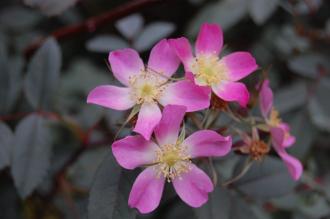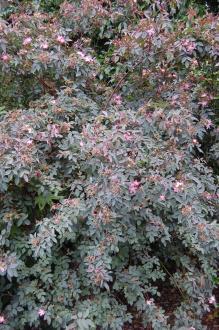
Rosa glauca Flower (30/06/2012, Kew Gardens, London)
Position: Full sun to light shade
Flowering period: Summer
Soil: Moist, well drained
Eventual Height: 2m
Eventual Spread: 2m
Hardiness: 2a – 9b
Family: Rosaceae
Rosa glauca is a vigorous, deciduous, medium sized shrub with an arching habit. Its blue/ green to purplish leaves are covered with a waxy bloom, are odd pinnate, up to 10cm long with up to 9 leaflets. Its stems or canes are red/ green and sparsely thorny. Its pink flowers are single, contain five petals, are up to 4cm across, have a white center with yellow stamen. Its fruit is a red hip which is 15mm across.
Rosa glauca, commonly known as the Red-Leaved Rose or the Redleaf Rose, is native to mountainous regions of central and southern Europe. Rosa glauca is synonymous with Rosa rubrifolia.

Rosa glauca (30/06/2012, Kew Gardens, London)
The etymological root of the binomial name Rosa is from the ancient Latin name for the rose. Glauca is from the Latin meaning ‘blueish grey’, in reference to the color of the leaves of this plant.
The landscape architect may find Rosa glauca useful as an effective informal barrier hedge. Strong winds will dislodge its petals.
Ecologically, R. glauca is attractive to pollinating insects. Its hips are attractive to birds during the winter months.
The Royal Horticultural Society has given R. glauca their prestigious Award of Garden Merit in 1993.
R. glauca prefers moist, humus rich, well-drained soils. It tolerates most pH of soil.
Rosa glauca requires little maintenance. Pruning should be carried out once flowering is complete. Obviously if pruning is carried out after flowering no hips will follow.

